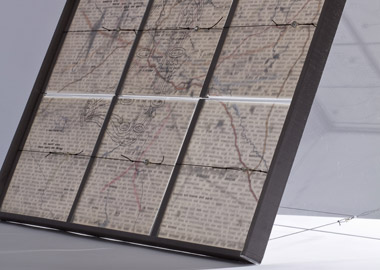Greenfield poet/artist/entrepreneur Chris Janke has done something remarkable: he’s conceived of a wildly unusual and quite literal deconstruction of the traditional poem format. This is not accomplished via some mere rearranging of words on a page. Instead, Janke has rethought the whole idea of a poetry volume, offering his work as something he calls an “art book,” though even that term doesn’t give a broad-enough sense of what he’s creating.
I’ve known Janke for some years, first as a poet and then in his continuing role as a co-owner of the Rendezvous in Turners Falls. Though it’s often hard to accurately or adequately describe how a poet writes, it’s safe to say that Janke’s current poems address the world at the level of the philosophical rather than, say, some traditional reverie about the beauty of an object or the natural world. His earlier work has seen its share of praise—he’s published a set of 10 prose poems, called Structure of the Embryonic Rat Brain, in traditional book format.
When we meet up to talk poetry, he has to go back out to the car a second time to bring in his new “book.” The thing is wrapped in a throw rug. It takes both of us to set it up, and it takes up a good portion of the table, standing up easel-like.
At first, it looks like a sort of semi-transparent set of nine line drawings with text, arranged like panes in a window. Words jump out here and there, fragments unclear in their connections, mysterious in their meanings. Fleetingly, I feel like a judge in a science fair. Panels—or, more accurately, folios of paper—get removed, and pages spill out.
The bottom page of each is, in some respects, “the poem,” or at least the closest thing here to a traditional poem. Even so, there are no line breaks. The six-by-six-inch page is marginless and filled with words. Atop that bottom layer, Janke has added what he calls “interpretations.” On some, a second poem is created by tracing some of the words underneath. Visual elements, too, come into play, subway maps and hybrid creations like a tracing of every occurrence of the word “of,” with each “of” representing a high point in a topographical map.
The whole book, creation, or whatever exactly it is, is called of the of of the of. That may sound like so much nonsense, but Janke’s fascination with the philosophy podcasts he tells me he’s been listening to offers a deepening of that strange phrase. Words seem to have become slippery for Janke. “What exactly is ‘understanding’?”, he offers. He seems wryly amused, but also genuinely mystified as he ponders that conglomeration of letter and sound. (And it’s true—what could standing under something have to do with comprehension?)
“The more I look at these things, the more they fall apart,” Janke says.
That falling apart seems to be precisely what he’s playing out in his sculptural poem-art. In his quilt of word, meaning and semi-transparent vellum, the traditional idea of “poem” seems distant—read the bottom pieces, the “poems” that serve as starting point or, as he says, “stable layers,” and meaning is elusive. The words combine in unusual, fragmentary ways, and abstract terms bump up against more commonplace ones, all without punctuation. They seem to be in need of the other pages, interpretive lenses with which to examine these denser layers. In that sense, there’s a way to judge these uncomfortably unusual pages: they do not seem frivolous, but necessary. They offer a coherence, and there’s a methodology at work—the layers have specific names, from “big bang layer” to “flight map layer,” and “map of spain layer.” Each contains visualizations that go with the moniker, and each can be displayed across the nine smaller booklets to form a larger image.
Janke has taken this new methodology to unusual lengths. At first, he says, he tried to talk to other editors (he’s senior editor of Slope Editions) about publishing of the of of the of. It wasn’t clear how it could be done, so Janke is in the process of building 20 copies, a couple of which are currently on display in art exhibitions.
He’s already moved on in some ways, though the building/publishing is incomplete. He offers imagery from newer work, including an installation at a friend’s house. That newer work involves poetry arising from place, and a literal framing of portions of the environment via hanging plexiglass. The whole madly ambitious work is scheduled for completion at the 2013 summer solstice.
For more info, visit christopherjanke.com.



